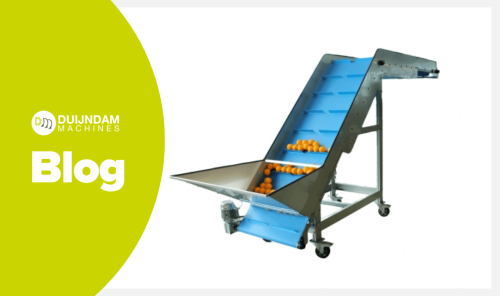Conveyor Belts; the Backbone of the Agricultural and Horticultural Sector

Conveyor belts form the backbone of efficient production processes in the agricultural and horticultural sectors. From harvesting crops to sorting and packaging them, these versatile machines play a crucial role. By their ability to quickly and accurately move products, conveyor belts contribute to increased productivity and improved quality of agricultural products. In this blog, we will discuss the different types of conveyor belts used, their specific applications in agriculture and horticulture, the benefits they offer to modern agricultural businesses, and why a second-hand conveyor belt might also be suitable for you.
What are Conveyor Belts Used for in Agriculture and Horticulture?
In the agricultural and horticultural sector, conveyor belts are naturally used to move products from point A to point B, but within what applications is this relevant? They are used, among other things, for:
Harvesting: Conveyor belts help with the fast and efficient harvesting of crops, reducing labor costs and time. Consider a harvest belt.
Sorting and Processing: After harvesting, products can be easily sorted and processed using various types of conveyor belts. These are often used in combination with sorting machines.
Packaging: Conveyor belts are used to transport products to packaging lines, ensuring a seamless transition between harvest and distribution.
Transporting: Within nurseries and agricultural businesses, conveyor belts are used to transport products over various distances, from the field to storage rooms or processing units.
The Benefits of Used Conveyor Belts for Your Business
The purchase of conveyor belts naturally contributes to the total investment amount. Because the cost of a new conveyor belt is higher, the return on investment (ROI) is often longer, which may delay the purchase of a new conveyor belt. This is unnecessary, as used conveyor belts are often a great alternative to new ones, and at a lower price. Besides the savings, used conveyor belts are also readily available.
When purchasing a second-hand conveyor belt, it's important to first know what you are looking for. Are you looking for a conveyor belt for agriculture or horticulture, or for example, for recycling or the food industry? Additionally, it's important to choose the right dimensions, as conveyor belts often have fixed dimensions and cannot be adjusted later (with the exception of telescopic belts, of course).
What Types of Conveyor Belts Are There?
Conveyor belts come in various types and sizes, each designed to efficiently perform specific tasks. Here is an overview of the different types of conveyor belts:
- Inspection Belts: Used for sorting and inspecting products.
- Hall Fillers: Ideal for filling large spaces or halls with products.
- Flat Belts: Simple and versatile belts for transporting various products.
- Elevating Belts: Designed to transport products upwards, often used for height differences.
- Trough Belts: Characterized by their trough-shaped structure, suitable for transporting bulk goods.
- Plant Conveyor Belts: Specially designed for transporting plants (in pots), often used in nurseries.
- Roller Inspection Belts: Equipped with rollers, ideal for inspecting and sorting products.
- Roller Conveyors: Suitable for transporting heavy products on rollers.
- Dosing Bunkers: Used to dose a constant stream of products.
- Dump Bunkers: For storing and dosing bulk products.
- Harvest Belts: Specially designed for harvesting and transporting crops.
- Curve Belts: Flexible belts used to make curves in transport systems.
- Telescopic & Duo Belts: Extendable belts that are flexibly deployable in length.
- Turntables: For rotating and sorting products.
- Screw Conveyors: For transporting products via a screw mechanism.
- Rod Belts: Belts with rods, ideal for transporting wet or dirty products.
Conveyor Belts for Food Processing
In the food processing industry, conveyor belts are indispensable for efficiently and hygienically moving products. They are used for sorting and inspecting, where food products can be easily sorted and inspected for quality. Processing; conveyor belts help move food products between different processing stations, such as cutting, washing, and packaging. Packaging and distribution; after processing, products are transported via conveyor belts to packaging lines and distribution centers. Conveyor belts for food processing are usually made from materials that meet strict hygiene requirements, such as stainless steel and food-grade rubber.
How to Choose the Right Conveyor Belt for Your Application
When choosing the right conveyor belt for your application, there are several important factors to consider:
- Application: First, determine what the conveyor belt will be used for. Different industries have different requirements.
- Type: Based on the application, you can find the right type of conveyor belt (see the previously mentioned list of types and their benefits).
- Dimensions: Ensure that the dimensions of the conveyor belt fit the space and the product being transported.
- Material: Choose a conveyor belt made from materials suitable for the specific conditions, such as bulk or food processing.
- Capacity: Ensure that the conveyor belt has the right capacity to handle the desired volume of products.
- Maintenance: Consider the ease of maintenance of the conveyor belt. Some types require more maintenance than others.
By considering these factors, you can choose the conveyor belt that best suits the needs of your business and applications. We always have a wide (400+ conveyor belts) but varying stock of used conveyor belts. Keep an eye on the conveyor belts page to see which used conveyor belts we have for sale.
 Request an offer (
Request an offer (